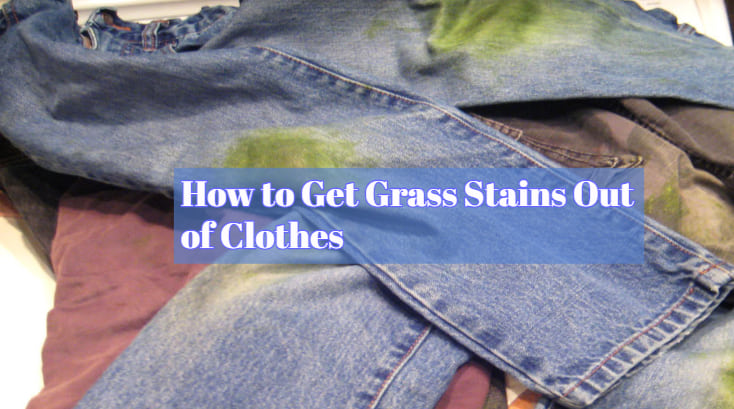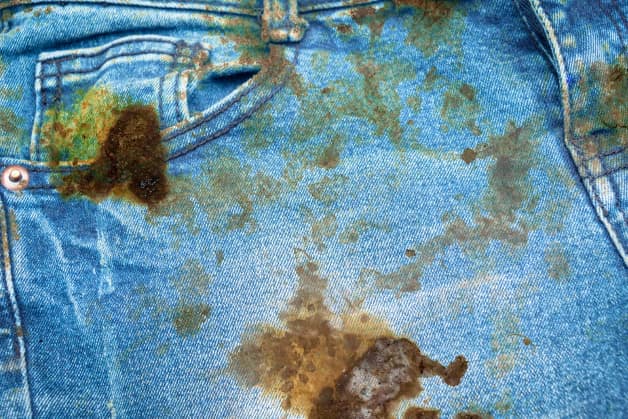As a busy parent, I know that grass stains on kids’ clothes are inevitable. From soccer practice to playing in the backyard, grass stains happen all the time. The green stains can be frustrating, but don’t worry – you can get them out! With the right techniques and products, you can banish grass stains for good.
In this complete guide, I’ll share everything I’ve learned about removing grass stains over the years. You’ll find tips on treating fresh stains, using homemade solutions, tackling stubborn old stains, and preventing grass stains in the first place. With a bit of effort, you can keep your family’s clothes looking like new.
Can Grass Stains Come Out of Clothes?
The good news is – yes! Grass stains can absolutely come out of clothes. While it may take a little extra effort compared to some other stains, grass stains are removable with the right techniques. The key is to act quickly before the stain has time to set.
Grass contains chlorophyll, which is the green pigment. When grass gets on your clothing, the chlorophyll bonds to the fibers. If left too long, it can become very difficult to remove. But by acting fast and using some stain-fighting ingredients, you can break those bonds and lift grass stains from fabric.
So if you’re wondering “can you get grass stains out of clothes?” – the answer is an emphatic yes! Don’t resign your favorite shirt to the rag pile just yet. Follow these grass stain removal tips and you can rescue clothes from grass stains.
Ways to Get Grass Stains Out of Clothes
When you notice a grass stain, start treatment right away. Here are some of the most effective ways to get grass stains out of clothes:
1. Rub With Dish Soap
One of the fastest ways to tackle a grass stain is to grab some dish soap. Apply a few drops directly to the stain. Gently rub the dish soap into the fabric using your fingers or an old toothbrush. Let it sit for a minute or two. Then rinse with cold water.
Dish soap helps break up grass stains thanks to the degreasing agents. The scrubbing action also helps lift the stained particles from the fabric. For light stains, dish soap may be all you need for “how to remove grass stains.”
2. Make a DIY Stain-Fighting Solution
Don’t have any pre-treatment on hand? No worries – you can whip up a homemade grass stain remover using common household ingredients.
Here are two easy DIY solutions to try:
Baking Soda Paste: Mix 1 tablespoon baking soda with 1 tablespoon water to form a paste. Spread the paste on the grass stain and let it sit for 30 minutes before washing. The alkaline baking soda helps neutralize the acid in grass stains.
Hydrogen Peroxide: Mix equal parts hydrogen peroxide and dishwashing liquid in a spray bottle. Lightly spritz the solution on the stain and let it bubble for a few minutes. Then rinse and launder as usual. The chemical reaction can help lift grass stains.
You can also boost the cleaning power of any DIY solution by adding a splash of white vinegar or lemon juice. The acid helps break down stubborn chlorophyll stains.
3. Use Oxygen Bleach on White Fabrics
For really stubborn grass stains on white clothes, shirts, or sheets, try using an oxygen bleach like OxiClean, Clorox 2, or Vanish. The active ingredient, sodium percarbonate, breaks down and lifts organic stains through oxidation.
Make a concentrated bleach solution by mixing 1-2 scoops of powdered bleach with 1 quart warm water. Pre-soak the stained item for 30 minutes to overnight. For heavy stains, rub a bit of the paste directly on the stain. Rinse and wash normally.
Note that oxygen bleach is safe for white fabrics only. Do not use chlorine bleach as it may damage or discolor the fabric.
4. Make a Vinegar Solution
White vinegar is a natural solvent great at breaking down organic compounds like grass stains. Fill a spray bottle with equal parts white vinegar and cool water. Mist liberally over the grass stain and let soak in for several minutes. Then rinse with cold water and launder as usual.
The acidic vinegar dissolves the bonds of the grass stain, making it easier to wash away. The longer you let it soak, the better it will work. Vinegar is inexpensive and works great when wondering “what gets grass stains out of clothes?”
5. Use Glycerine and Detergent
Here’s another unusual but effective remedy. Apply a few drops of glycerine directly onto the grass stain. Let it soak in for 10 minutes. Then make a paste with laundry detergent and warm water and scrub it into the stain by hand. Allow it to sit for 1 hour before rinsing and washing as usual.
The glycerine helps soften the chlorophyll particles so the detergent can lift the stain more easily. The scrubbing action also helps dislodge the stain. Who knew glycerine from the pharmacy could be a grass stain removal secret weapon?
6. Sponge with Isopropyl Alcohol
Another ingredient already in your home can help remove fresh grass stains – rubbing alcohol! Grab a bottle of isopropyl alcohol and a clean cloth or sponge. Gently dab at the stain to apply the alcohol. Let it soak in for a few minutes, then rinse with cold water.
The alcohol will help dissolve the chlorophyll bonds. Be sure to fully rinse after, as leaving alcohol in fabric can lead to discoloration later. When wondering “how you can get grass stains out of clothes?”, reach for the rubbing alcohol!
Is Hot or Cold Water Better for Grass Stains?
When trying to remove grass stains from clothes, always use cold water. Hot water can actually set stains into fabric rather than remove them.
The heat from hot water causes the stain molecules to bond more tightly to the fibers. It makes the stain harder to extract. With all grass stain removal methods, rinse with cool or cold water.
Warm or hot water is fine for washing after pre-treating. But during the stain-fighting process itself, cold water is best. Then launder as usual with detergent and the recommended water temperature for the fabric.
Does Grass Stain Permanently?
If not treated promptly, grass stains can become permanent. The green chlorophyll particles can bond tightly and oxidize over time. Given days or weeks, it becomes very hard to remove a grass stain fully.
That said, you’d be surprised how long you have to treat a grass stain. If the clothing is not dried, you can usually get fresh grass stains out within the first 1-2 days. For dried stains up to a week old, the stain may still come out with repeated treatments.
But for maximum success, begin stain removal right after the stain occurs. The sooner you can break those chlorophyll bonds, the better. Catching grass stains early on can make the difference between removing them completely versus remaining faded shadows.
Conclusion
If you’ve ever had to deal with pesky grass stains, you know how frustrating they can be. But while grass stains may be stubborn, the good news is they can be removed with the right techniques.
Acting quickly is key – the sooner you can treat fresh stains, the better. For wet stains, dish soap, rubbing alcohol, or vinegar all help dissolve chlorophyll bonds so you can wash the stain away. Baking soda paste scrubs away stains and can be applied even once grass stains have dried.
Always use cold water when pre-treating to avoid setting in stains with heat. Soak and agitate stained fabric to give stain fighters time to work. With prompt treatment and some elbow grease, you can rescue clothes from grass stains and save your favorite summer outfits.
I hope these grass stain removing tips help you keep your family’s clothing looking fresh and bright. Share your own grass stain battles and cleaning victories in the comments!
FAQs About Removing Grass Stains
How do you get dried grass stains out of clothes?
For dried or set-in grass stains, hand wash using a heavy duty stain remover made for stuck-on organic stains. Soak for 30+ minutes, vigorously rub the stain, rinse, and repeat if needed. This manual scrubbing action helps lift out the chlorophyll.
What is the best grass stain remover?
Look for laundry pre-treaters and stain removers that specifically say they work on chlorophyll, plant stains, or grass stains. Some popular effective products are OxiClean, Grandma’s Secret Spot Remover, and Carbona Grass Stain Remover.
What removes old grass stains?
To remove stubborn, older grass stains, try soaking in hot water with a booster additive like Borax or OxiClean. For white clothes, soak in an oxygen bleach solution. Then hand wash the stain with a scrub brush and stain remover. Old stains may need repeat treatments.
What is the fastest way to get grass stains out?
For fresh stains, quickly rinse with cold water or a stain removal wipe. Apply a laundry pre-treatment spray and let it sit 5-10 minutes before washing on hot. This rapid response can often remove new grass stains completely in one wash.
How do you get grass stains out of white clothes?
Make a paste of baking soda, hydrogen peroxide, lemon juice or OxiClean and let it sit on the stains for 30 minutes before washing. For tough stains on white fabrics, soak in an oxygen bleach solution before washing. Avoid using chlorine bleach as it can cause yellowing.
Can you get grass stains out with just washing?
For light, fresh grass stains, sometimes normal laundering with detergent on hot is enough. But for most stains, best results come from pre-treating with a stain remover before washing. For heavy stains, hand washing works better than just throwing in the washing machine.
How do you get grass stains out of cotton?
Apply a laundry pre-spray and let it sit before washing. For tough stains, make a paste with baking soda, lemon juice or OxiClean and scrub by hand before laundering. Wash cottons on the hottest setting safe for the fabric. Air dry instead of machine drying.
How do you remove grass stains from white shoes?
Mix baking soda and hydrogen peroxide into a paste and apply to stained sneakers. Let it bubble for 15 minutes, then scrub with an old toothbrush. Rinse and repeat if needed. Stuff shoes with paper towels and air dry to avoid heat setting the stain.

